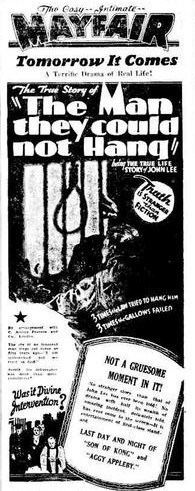The Man They Could Not Hang (1934 film)
4 /10 1 Votes4
Duration Country Australia | Genre Drama Writer Lorrie Webb Language English | |||||||||||||||||||||||||||||||||
 | ||||||||||||||||||||||||||||||||||
Release date 1 June 1934 Based on dramatisation by Rigby C. Tearle of the autobiography of John Lee Similar movies On Our Selection (1920), The Sentimental Bloke (1919), The Phantom Stockman (1953), Smithy (1946), Bush Christmas (1947) | ||||||||||||||||||||||||||||||||||
The Man They Could Not Hang is a 1934 Australian film directed by Raymond Longford about the life of John Babbacombe Lee, whose story had been filmed previously in 1912 and 1921.
Contents
Synopsis
In Devonshire, John Lee works for wealthy spinster Emma Keys. On the night he is engaged to be married, Keys is murdered and Lee is arrested on circumstantial evidence and is convicted of murder. He is condemned to death but when the authorities try to execute him he trap doors will not open. they fail a second time and his sentence is commuted to life imprisonment. There is a sub-plot about smuggling and secret service agents.
Cast
Production
The production company responsible for the film, Invicta, was formed by J.A. Lipman, in 1933 with capital of ₤5,000. Lipman hired Raymond Longford and produced the film under the name of 'Rigby C. Tearle'. The story had been filmed twice before to great box office success. Eric Bedford wrote the scenario.
Lipman leased the No. 2 studios of Cinesound Productions at Rushcutters Bay, which had just been used for When the Kellys Rode. Shooting started on 12 March 1934 with Cinesound crew.
The cast included Arthur W. Sterry, who exhibited the 1912 version of the story and directed the 1921 one.
Release
A few days prior to the film's premiere, the New South Wales police requested a number of cuts be made to the film regarding its depiction of the police. This was done, even though the film was set in England.
Longford was unable to attend the premiere due to illness. In Sydney is screened on a double bill with Cinesound Varieties.
The film was given a poor critical reception, the Sydney Morning Herald calling it:
Purely antiquarian. The very language of the characters is far-off and unreal... could have been directed in a more convincing way.. The one bright spot in the whole melancholy chronicle is the acting of Mr. Ron Roberts... Given better material, this young man could do some excellent work.
The critic from The Argus said that the film was:
Closer to the far-fetched melodrama of The Streets of London than to the realism of the better films of to-day. The story... doubtless contains good dramatic material, but Invicta Films, an Australian company, have so disguised it that it appears sillier than the creations of the hack scenario writer's fancy. The complicated story has been unwound in a rambling, disjointed fashion, and the dialogue is so childishly stiff and melodramatic that even the most docile audience is fidgeting and giggling before the end. The cast is full of those stage types that went out with the appearance of Pinero – the red-eyed village maiden, who murmurs "Justice will prevail", the moustached French villain, who cannot speak without leering, smirking and kissing his finger- tips, and the stalwart British policeman, who arrests the wrong man with the noble words, "Duty is duty." The spirit of the piece seems to have possessed the cast completely, but perhaps the stiffness of the acting is due to their ignorance of the difference between stage and screen technique.
The Courier Mail did say "the prison scenes are realistically done, and at times the tension is strong."
The film obtained a small release in England where it also received bad reviews.
The movie performed solidly in country areas. However, by the end of 1934 a trade paper reported it as having earned only £2,200 at the Australian box office with the possibility of this going up to £3,000 ("although it's doubtful") and the sale to England giving it a chance to recoup the budget. It is unclear whether this happened.
Longford never made another feature as director.
References
The Man They Could Not Hang (1934 film) WikipediaThe Man They Could Not Hang (1934 film) IMDb
